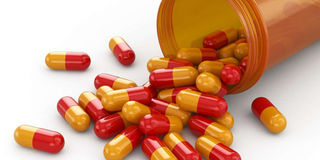Scientists discover cheap and fast way to create new antibiotics

Cancer researchers may have stumbled upon a solution to reverse antibiotic drug resistance and stop some drug resistant infections. PHOTO| FILE| NATION MEDIA GROUP
Drug resistance is an escalating problem. The World Health Organisation (WHO) has estimated that 700,000 people around the world die annually from drug resistant infections.
In the evolutionary arms-race between deadly bacteria and the antibiotics used by doctors to kill them, the bugs have definitely been gaining the upper hand in recent years, making it difficult for scientists to discover new antibiotics.
Many pharmaceutical companies have also left the field, because it is hard and there are no reliable long-term markets.
New antibiotics are used as little as possible to conserve their potency. When they are widely used, resistance begins to set in and they cease to be effective.
Antibiotics (Antimicrobial) resistance occurs when a strain of bacteria evolves to resist each consecutive treatment, until no treatments are left, leaving the so-called ‘superbugs’ incurable.
MORE POTENT ANTIBIOTICS
Antibiotics have become less effective against certain bacteria largely due to overuse and misuse of antimicrobials, pushing some experts to advise against completion of the medication once the patient feels better.
Already, experts have warned that we are decades behind in the race against superbugs having already exploited naturally occurring antibiotics, with the creation of new ones requiring time, money and ingenuity.
But a team of scientists at the University of Salford in the UK, say they may have found a very simple way to reverse antibiotic drug resistance and stop resistant infections such as Methicillin-resistant Staphylococcus aureus (MRSA).
They have created and validated several new antibiotics – many of which are as potent, or more potent, than standard antibiotics.
They were researching new compounds that might be effective against cancer stem cells, when they accidentally invented a systemic way of creating new antibiotics which is simple, cheap and could be very significant in the fight against superbugs.
MRSA causes infections in different parts of the body. It’s tougher to treat than most strains of staphylococcus aureus because it is resistant to some commonly used antibiotics.
The researchers specialise in cancer stem cells, specifically methods of inhibiting energy production in mitochondria, the “powerhouse” of cells. One of the team’s work is how antibiotics can be effective against these mitochondria, which have a lot in common with bacteria.
The team sorted through 45,000 compounds, using a three-dimensional structure of the mitochondrial ribosome.
Results of their study coincided with another study that found a new class of antibiotic to work in the laboratory against the sexually transmitted infection gonorrhea.
The World Health Organisation listed drug resistant gonorrhoea, caused by the Neisseria gonorrhoeae bacterium, as a high priority infection that poses a great threat to human health, estimating that there about 78 million gonorrhoea infections and 700,000 deaths worldwide each year.
Researchers say that the antibiotic known as Closthioamide, discovered in 2010, might eventually offer an alternative for current drugs that are becoming less effective against gonorrhoea.
Although it is early days, because the antibiotic has yet to be tried in animals or humans, researchers say they are excited by its potential. Closthioamide was tested in the lab against samples of the Neisseria gonorrhoeae bacterium.
They tested 149 samples of bacteria from hospital patients with infections in the throat, urethra, cervix and rectum. Very small amounts of the antibiotic were effective against 146 of the 149 samples.
Victoria Miari, lead author from LSHTM, said: “The results of our initial laboratory studies show that closthioamide has the potential to combat N. gonorrhoeae. Further research is needed, but its potential to successfully tackle this infection, as well as other bacteria, cannot be underestimated.”
DRUG RESISTANCE
According to the World Health Organisation 700, 000 people around the world die every year due to drug-resistant infections. Antibiotic resistance occurs when a strain of bacteria evolves to resist each consecutive treatment, until no treatments are left, leaving superbugs that are incurable.



